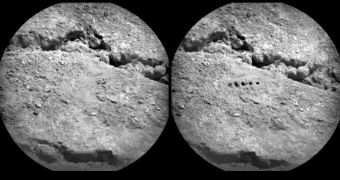The Mars Science Laboratory (MSL) rover Curiosity used its Chemistry and Camera (ChemCam) instrument again on August 25 (sol 19), poking a series of holes in a patch of soil. Unlike previous tests, this one saw the robot's powerful laser poke the ground at different locations.
The holes were laid out side-by-side, enabling scientists to observe any potential differences in the results the spectrometer returned. The image to the left shows the target as it appeared before the test (left) and afterwards, once five marks had been permanently indented on the Martian surface.
Experts at the Jet Propulsion Laboratory (JPL) in Pasadena, California – who manage MSL for NASA – say that the test was conducted from around 3.5 meters (11.5 feet) away, and that each of the circular fields of view is around 7.9 centimeters (3.1 inches) across.
The data were collected using the ChemCam Remote Micro-Imager. The target patch of soil was named Beechey. Every single hole in the image to the right received a total of 50 laser shots, meant to assess chemical variability at short scales.
Each of these blasts produced a small amount of plasma, which was observed by ChemCam. By analyzing all the resulting photos, scientists can figure out the contents of the target, and assess if some other material is covering the surface.
From 3.5 meters away, ChemCam's laser should have produced a 0.43-millimeter (0.017-inch) wide hole, but the recorded diameter of the poke marks was between 2 to 4 millimeters (0.08 to 0.16 inch).
According to the JPL team, this demonstrates that the light source – which delivers around a million watts of power for about five billionths of a second – is capable of removing unconsolidated grains and dust from its target, upon firing.
ChemCam was built and tested by experts at the US Department of Energy's (DOE) Los Alamos National Laboratory (LANL), in New Mexico. French experts from CNES and CNRS were also involved in the ambitious project.
MSL arrived on the surface of Mars on August 6, and landed near the slopes of Mount Sharp, inside Gale Crater. Its first few days were spent uploading new software, testing some of its instruments, and taking three short drives.
Curiosity is now moving towards its first science target, an outcrop called Glenelg. A couple of days ago, it completed a 16-meter (52.5-foot) drive. Glenelg is around 400 meters (1,312 feet) away from Bradbury Landing, where the rover touched down.

 14 DAY TRIAL //
14 DAY TRIAL //